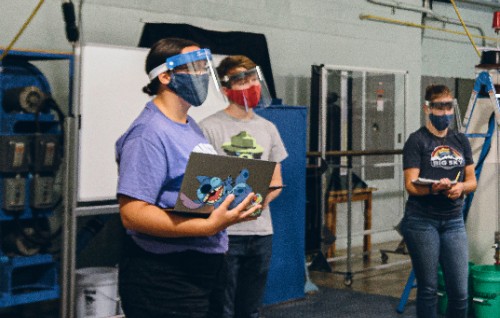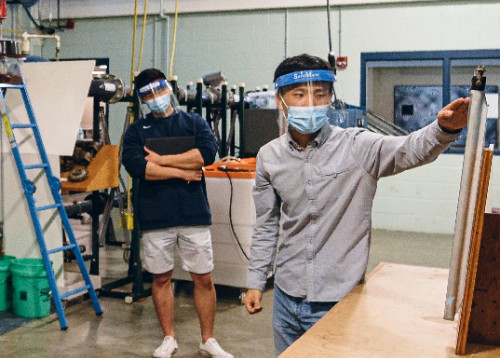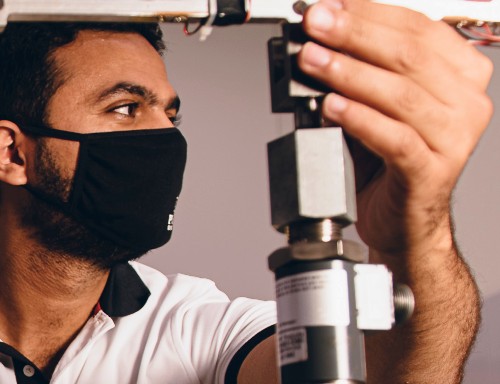A Resilient Return
Protect Purdue plan provides framework for safe semester on campus
One year ago, Abdullah Alghossoon stood in the CE 270 lab (now the Rick and Penny Conner Structural Engineering Lab), shoulder to shoulder with undergraduates clustered around a workbench. The fourth-year PhD student and TA for Introductory Structural Mechanics demonstrated how to examine the concept of the truss system experimentally by measuring the strain values from the attached sensors and recording the measurements of the loads, where the loads are being applied at any given time. He encouraged students to touch the analytical instruments and to experiment by making adjustments to the model truss.
The Structural Mechanics Lab has been taught in this method for decades. But in planning the lab schedule for Fall 2020 during the COVID-19 pandemic, Alghossoon and his fellow TAs collaborated with course instructor Robert Connor, the Jack and Kay Hockema Professor in Civil Engineering, to devise a new method of instruction.
"Our priority was to balance teaching with keeping the lab safe," Alghossoon said. "We usually have six or seven students at each of the workbenches. Their collaboration requires touching everything in the experiment. It would be impossible to maintain safe social distancing. Some students had already elected to take the course online, so we’d be producing videos for those students anyway. Therefore, we decided to present each lab virtually this semester."
Alghossoon recorded about half of the videos for the course. The recordings are posted in the virtual classroom, so the TAs are on hand to answer students' questions. Alghossoon relied on his previous experience teaching the lab to integrate common questions students ask.
"With every experiment, we have errors," he said. "That is how students learn. In the videos, I ask questions for students to consider instead of giving direct information. 'What kind of forces have we neglected at this point? What are the consequences of mismeasurements on these dimensions?' Sometimes, I intentionally introduce an error as a teaching element to explain how such a problem can be addressed."
From Alghossoon's perspective, teaching the lab virtually enhances the learning process. Typically, students only conduct an experiment once, without an opportunity to try it again and recover from their mistakes. Recording each experiment provides students with a catalog of videos that can be rewatched as many times as needed to understand the course material.
"Weekly meetings are conducted by the TAs and the course instructor to review the records and discuss next week's agenda," he said. "We've expanded our office hours. If they have questions, they can ask, and they can always refer back to the videos."

A hybrid model of virtual and in-person learning was among the many components of the Protect Purdue Plan announced over the summer to safely reopen campus for the fall. Michael B. Cline (BSCE '88), senior vice president for administrative operations at the University, led the buildings and infrastructure working group as part of the Protect Purdue implementation team.
"The University implemented a number of building safety measures as part of the comprehensive Protect Purdue Plan," Cline said. "In addition to de-densifying spaces, air handling units were reprogrammed to maximize outdoor air percentages; high-touch surfaces and public spaces received frequent, intensive disinfection; and signage was installed throughout campus to reinforce tenets of the Protect Purdue Plan."
In adherence with the Protect Purdue Plan, the Lyles School of Civil Engineering enacted several safety measures to promote the health and safety of students, faculty and staff. "In the interests of safety, we have shut down most common spaces," said Rao S. Govindaraju, the Bowen Engineering Head of Civil Engineering. "Computer labs are available for remote access only, conference rooms will be operated with reduced occupancy and only by reservation, classrooms have had chairs and desks removed for de-densification and research is conducted under current health protocols. Instructors are using HyFlex and other options for classroom de-densification. Most office hours and help sessions are being conducted virtually, as are all faculty meetings."
The safety protocols implemented by University administration, under the guidance of medical experts, center around the individual responsibility outlined in the Protect Purdue Pledge. The pledge implores every person on campus to adhere to safe health practices such as properly wearing face masks in all buildings and outside when social distancing is not possible and practicing robust personal hygiene, including frequent handwashing and sanitation of shared surfaces like desks.

Back in class
When campus closed in March, JT Sarisky, a junior with a structures concentration, packed up her residence hall room and drove home to Pennsylvania. She found adapting to strictly online classes challenging and as eager to be back in the classroom this fall.
"I was really excited to return to campus for in-person classes," Sarisky said. "Learning concepts in class and then applying them in the lab helps foster great learning. In my hydraulics lab, there are fewer students and we wear face shields and safety glasses along with our face masks. The TA conducts the experiment, so I don't actually touch any equipment. But I'm mainly a visual learner and being able to see things first-hand helps me to understand."
As a civil engineering student, Sarisky acknowledges the opportunity to learn from the University's efforts to adapt to the challenges presented by the pandemic. "Understanding how SARS COV-2 lives on surfaces, how long it is airborne, how it might circulate through HVAC systems, these questions directly relate to civil engineering," she said. "It's one of the most pivotal considerations for a building — people must be safe and comfortable living in the space."
Ethan Edwards, a senior concentrating in environmental engineering from Blacksburg, Virginia, felt prepared returning to campus thanks to the extensive communication shared with students in advance of the fall semester. "They made it pretty clear what we would be seeing once we got to class," Edwards said. "Seats are labeled, you disinfect your desk, plexiglass shields are available for professors. Given everything that's been going on, this semester felt surprisingly normal."
Under the tutelage of Andrew Whelton, associate professor of civil engineering and environmental and ecological engineering, Edwards researches the effectiveness of water filters, such as those found in a Britta or Pur filtration pitcher, against high levels of contamination. Last year, Edwards estimates he spent three to five hours running experiments in the lab each week. Though he was able to return to the research lab this fall, it required more planning to reserve lab space and equipment, specifying the steps of his process in advance — down to which analytical instrumentation he'd be using at what time — to ensure researchers were adequately spread out across the lab.
With his focus in environmental engineering, Edwards appreciates the similarities between the University's response to the pandemic and how authorities respond to other disasters. "Viewing it from a student stakeholder position shows the importance of decision-making grounded in science and open communication surrounding decisions being made," he said. "When the University is transparent about the actions it's taking and shares those results through a dashboard, there are a lot of parallels between that and a disaster with a drinking water system. You have to communicate the extent of the contamination and its effects, outline the steps you are taking to correct it and detail how you intend to prevent future events from happening as well."
While civil engineering students may be uniquely positioned to learn from the challenges presented by COVID-19, they aren't the only ones adapting to campus life during the pandemic.
"It's not normal for any of us," said Dave Rater, facility manager for Hampton Hall. "It's been refreshing to see how everyone across civil engineering has pitched in. We've had to do things differently. It takes extra steps and a bit more time to get everything prepared, but everyone has been incredibly positive. Faculty and staff have had to step out of their normal routine, but we're united on our efforts to provide a quality education experience for students in a safe environment."

